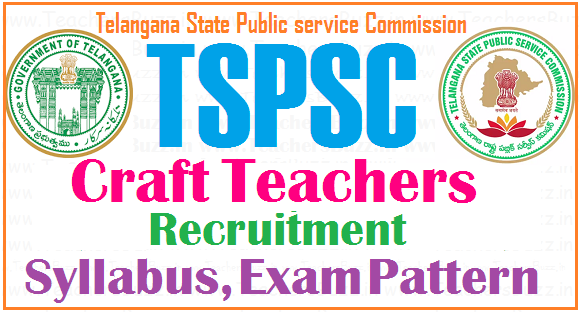TSPSC Craft Teachers Recruitment Syllabus, Exam Pattern/ Scheme of Examination.
TSPSC TS Residential Craft Teachers Recruitment Syllabus, Exam Pattern/Scheme of Examination, TSPSC ArtTeachers Syllabus, Exam Pattern, TSPSC Craft Teachers recruitment syllabus,exam pattern, TSPC Gurukulams Craft Teachers recruitment syllabus,exam pattern; Scheme and Syllabus for the post of Craft Teachersin Residential Educational Institution Societies; Preliminary (Screening Test) Scheme and Syllabus, Main Examination Scheme and Syllabus for the post of Craft Teachers. TSPSC TS Social welfare Gurukulam Art TeachersPosts Recruitment examination pattern, TSREIS(School Education), TSWREIS (Social Welfare), MJP TSBCWREIS (BC Welfare), TSTWREIS(Tribal Welfare), TSMWREIS (Minority Welfare) Art TeacherPosts Recruitment Scheme of exam. TS REIS’s Craft TeachersRecruitment syllabus, exam scheme, tspsc tswreis, mjp bcwreis, tstwreis,tmreis Craft Teachersrecruitment syllabus, exam scheme details are given here.
Scheme & Syllabus-Residential Educational Institution Societies:
TSPSC Craft Teachers recruitment Syllabus, Exam pattern (Scheme of exam).Scheme and Syllabus for the post of Craft Teacher in Residential Educational Institution Societies
| Written Examination (Objective
Type) |
No. of
Questions |
Duration
(Minutes) |
Marks | |
| Paper | General Studies and Craft and Craft Education | 200 | 180 | 200 |
| Total | 200 | |||
Paper :Studies and Craft and Craft Education. .
Section-I: General Studies
1. Current Affairs – Regional, National & International.
2. Indian Constitution; Indian Political System; Governance and Public Policy.
3. Social Exclusion; Rights issues such as Gender, Caste, Tribe, Disability etc., and inclusive policies.
4. Society Culture, Civilization Heritage, Arts and Literature of India and
Telangana
5. General Science; India’s Achievements in Science and Technology
6. Environmental Issues; Disaster Management- Prevention and Mitigation
Strategies and Sustainable Development.
7. Economic and Social Development of India and Telangana.
8. Socio-economic, Political and Cultural History of Telangana with special emphasis on Telangana Statehood Movement and formation of Telangana state.
9. Analytical Abilities: Logical Reasoning and Data Interpretation.
10. Moral Values and Professional Ethics in Education.
Section-II: Craft and Craft Education
I. Sewing Machine – Parts – Common Faults and Remedies, Equipment and Materials used in Garment Construction – Preparation of Fabric – Shrinking, Straightening and Pressing
II. Plain Needle Work
a. Basic Teachers – Even basting, Uneven basting, Running, Hemming and
Back Stitch.
b. Seams and Seam Finishes – Plain Seam, Lapped Seam, French Seam, Run and Fell Seam, Pinked Seam Finish, Edge Stitch seam Finish, Double stitch seam finish, Herring Bone stitch seam finish.
c. Fullness in Garments
a. Darts – Types – Single pointed darts, Double pointed darts and Decorative darts.
b. Tucks – Types – Pin Tucks, Corded Tucks, Cross Tucks c. Pleats – Types – Knife pleats, Box pleats.
d. Finishing of Raw edges and Finishes – Facing, Piping, Binding, False Hem.
e. Placket opening and Fastners
f. Placket Openings – Simple Hem, Continuous Wrap Opening, Two Piece Bound opening
g. Fastness – Button, Button holes, Shank buttons, Hooks and Eyes, Zips.
III. Collars, Pockets, Sleeves and Yokes
a. Collars – Types – Peter Pan Collars, Cape Collars, Shirt Collar.
b. Pockets – Types – Patch Pocket, Flap Pocket, Seam, Bound Pocket. c. Sleeves – Plain Sleeves, Puff Sleeves
d. Yokes – Round yoke and Square yoke
IV. Mending
a. Darning – Types – Straight Tear, Hedge Tear b. Patch Work – Plain Patch and Printed Patch
V. Drafting of Jangia and Jabla
a. Drafting of Jangia b. Drafting of Jabla
VI. Drafting of Princess Petticoat, Frocks and Saree Petticoat
a. Drafting of Princess Petticoat b. Drafting of Frock
c. Drafting of Saree Petticoat
VII. Drafting of Others
a. Drafting of Skirt; b.Drafting of Saree Blouse; c. Drafting of Punjabi Shirt b. Drafting of Shalwar; d.Drafting of Chudidar
VIII. Embroidery
a. Tools, Techniques and Materials used in Hand Embroidery b. Enlarging and reducing the design
c. Single line embroidery stitches – Running, Stem, Chain, Double knot stitch, Couching, Fly and Feather Stitch.
d. Filling Stitches – French knot, Satin, Herring bone, Button hole, Long and short stitch.
e. Contemporary stitches – Shadow stitch, Cross Stitch, appliqué stitch. f. Banjara Work – Mirror work, quilting, Drawn thread work, Bead work.
IX. Machine Embroidery – Cording, Running, Round, Long and Short, Satin, Twine
Cording, Applique Work, Net Work, Eyelet Work, Quilting Work
X. Psychology
1. Methods and advantages of Educational Psychology
2. Laws of learning
3. Types of Intelligence
4. Intelligence Quotient
5. Personality Traits, Factors responsible
XI. Philosophy
1. Study of relationship between Philosophy and Education
2. Aims of Education
3. Universal free and Compulsory Education
4. Use of Audio visual aids for teaching
5. Importance of work experience in Education
XII. Methods of Teaching
1. Factors of Teaching and learning
2. Principles (Maxims) of Teaching
3. Steps in lesson planning 4. Methods of Teaching
XIII. Curricular and Co-Curricular Activities
1. Importance of Curriculum
2. Importance of Co-Curricular Activities on the Campus such as Workshops and
Seminars, Conferences, Exchange Programmes, Art Competitions
XIV. Telangana Craft
(adsbygoogle = window.adsbygoogle || []).push({});
1.Syllabus and Exam Pattern for Principals
2.Syllabus and Exam Pattern for Staff Nurse
3.Syllabus and Exam Pattern for Trained Graduate Teachers
4.Syllabus and Exam Pattern for Physical Director
5.Syllabus and Exam Pattern for Physical Education Teacher
6.Syllabus and Exam Pattern for Post Graduate Teacher
7.Syllabus and Exam Pattern for School Librarians
8.Syllabus and Exam Pattern for Music Teacher
9.Syllabus and Exam Pattern for Art Teacher
10.Syllabus and Exam Pattern for Craft Teacher
11.Syllabus and Exam Pattern for Junior Lecturers
12.Syllabus and Exam Pattern for College Librarians
1. TSPSC Gurukulam TGT Recruitment 2017 Notification, Apply online.
2. TSPSC Gurukulam PGTs Recruitment 2017 Notification, Apply online
3. TSPSC Gurukulam PDs Recruitment 2017 Notification, Apply online
4. TSPSC Gurukulam PETs Recruitment 2017 Notification, Apply online
5. TSPSC Gurukulam Art Teachers Recruitment 2017 Notification, Apply online
6. TSPSC Gurukulam Craft Teachers Recruitment 2017 Notification, Apply online
7. TSPSC Gurukulam Music Teachers Recruitment 2017 Notification, Apply online
8. TSPSC Gurukulam Staff Nurses Recruitment 2017 Notification, Apply online
9. TSPSC Gurukulam Librarians Recruitment 2017 Notification, Apply online

